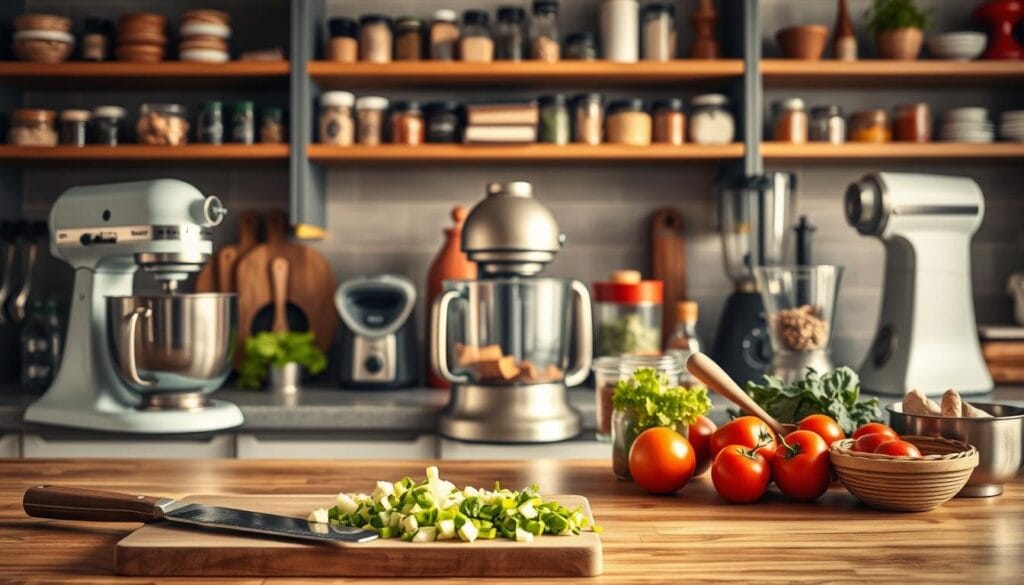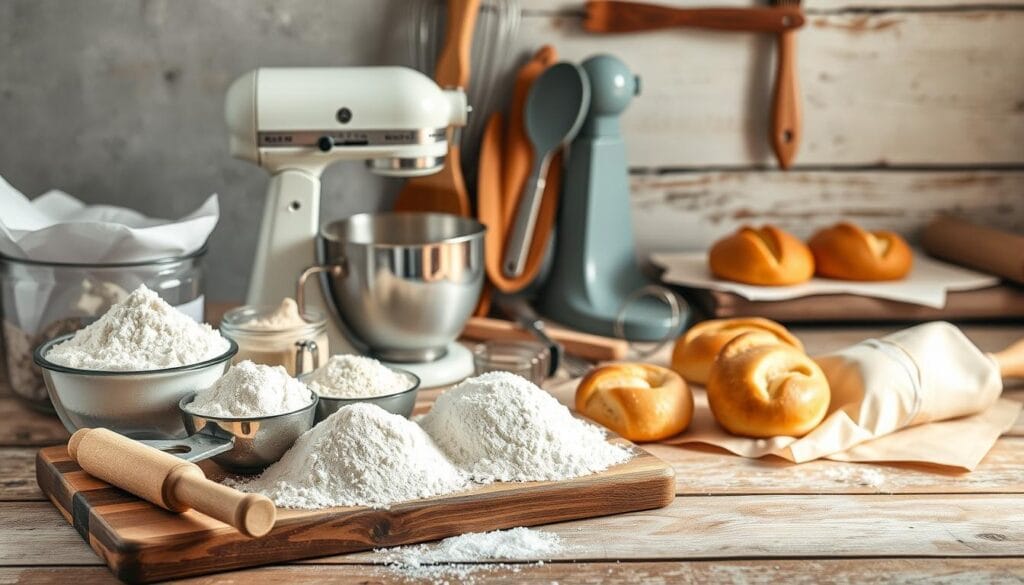Culinary Essentials, Did you know about 70% of home cooks call themselves “foodies”? They want to get better at cooking and try new recipes. This shows how important it is to learn how to cook and bake well.
Learning to cook can really improve your health. Home-cooked meals are full of fruits, veggies, and fiber. They also have less bad fat and salt. So, cooking like a pro helps you eat better and make smart food choices.

Culinary Essentials, Key Takeaways
- Learning how to prepare food and master various cooking techniques can improve your health and wellbeing
- Cooking classes and culinary programs can provide valuable skills and knowledge
- Home-cooked meals can be budget-friendly and reduce environmental waste
- Mastering easy recipes and cooking techniques can increase your confidence in the kitchen
- Understanding the importance of seasoning and presentation can elevate your cooking to the next level
- Investing in quality kitchen tools and equipment can make a significant difference in your cooking experience
Understanding cooking basics opens up a world of flavors in your kitchen. Whether you’re new or experienced, learning to cook well changes your culinary journey.
Essential Kitchen Setup for Professional Cooking
To become a skilled cook, you need a well-organized kitchen. A professional kitchen setup is perfect for learning and practicing kitchen skills and culinary techniques. Experienced chefs can help you master meal preparation and build a successful culinary career.
A professional kitchen is organized with specific areas for food prep, cooking, and cleaning. This setup helps you work more efficiently and safely. For example, using a “left to right” workflow when deep-frying can lower spill and burn risks by up to 60%. Cleaning as you go can also cut down kitchen cleanup time by about 50%.
- Using a dedicated scrap container to reduce waste disposal trips
- Preparing ingredients in advance with a “mise en place” approach
- Having a landing zone for prepped ingredients to speed up work
By following these tips, you can improve your kitchen skills and become a more efficient cook.
Culinary Essentials, Understanding Ingredients and Their Properties
Exploring cooking means learning about ingredients and how they work together. This knowledge helps you master cooking methods like roasting and sautéing. It also lets you create tasty recipe ideas that show off your cooking skills. For baking essentials, the right ingredients and tools are key for great textures and flavors.
Let’s examine some important ingredients and their roles:
- Dry ingredients, such as flour and sugar, are vital for baking. They give your creations structure.
- Moist ingredients, like eggs and butter, add flavor and softness to your dishes.
- Aromatics, including onions and garlic, add depth and complexity to your cooking methods.
Knowing how these ingredients work lets you make recipe ideas that taste great and look good. For instance, the right mix of dry and moist ingredients can make your baked goods perfect. Also, learning different cooking methods helps highlight each ingredient’s unique flavors and properties.
Keep practicing as you explore cooking. Try out different ingredients and cooking methods to get better. With time and effort, you’ll become a kitchen master. You’ll be able to make delicious dishes with confidence and ease.
Culinary Essentials, Mastering Basic Knife Skills
Learning basic knife skills is key for any cook, at home or in a pro kitchen. It cuts down food prep time and boosts kitchen efficiency. With practice, you’ll chop, dice, and mince like a pro, making cooking fun and recipes simple.
Focus on knife handling, various cuts, and keeping your knives sharp. Mastering these skills means you can chop ingredients safely and quickly. For instance, uniform food cuts help with even cooking. And using a sharp knife and stable board improves your kitchen skills.
Practice different cuts like dicing, mincing, and slicing. Try new ingredients like onions, garlic, and herbs. Always use a sharp knife and a stable board for safety and efficiency. With regular practice, you’ll get better and more confident in the kitchen.
How to Prepare Food: Professional Techniques
As you continue on your culinary journey, mastering professional techniques for preparing food is essential. This involves understanding various meal preparation tips, culinary techniques, and exploring new recipe ideas. To become proficient in these areas, it’s crucial to learn from experienced chefs and practice regularly.
A key aspect of professional food preparation is attention to detail and presentation. This includes proper knife handling, chopping, and sautéing techniques. By mastering these skills, you’ll be able to create dishes that are not only delicious but also visually appealing. Some essential techniques to focus on include dry rubs, marinades, and various cooking methods such as poaching, simmering, and braising.
When it comes to culinary techniques, there are numerous methods to explore. For example, dry heat cooking operates at high temperatures to induce browning, while moist heat cooking uses lower temperatures to cook food more gently. Understanding these techniques and how to apply them will help you to create a wide range of dishes, from roasted meats to steamed vegetables. Additionally, experimenting with different recipe ideas will allow you to develop your own unique style and flair in the kitchen.
By incorporating these professional techniques into your cooking routine, you’ll be able to take your culinary skills to the next level. Remember to always follow proper safety and sanitation guidelines, and don’t be afraid to try new things and make mistakes. With practice and patience, you’ll become a skilled chef, capable of creating delicious and visually stunning dishes that impress anyone.
Culinary Essentials, Fundamental Cooking Methods Every Chef Should Know
Learning different cooking methods is key for chefs. It lets them make many kinds of dishes. These methods are divided into dry heat, moist heat, and mix cooking. Knowing these is vital for being good in the kitchen.
Improving your kitchen skills takes practice and patience. It doesn’t matter if you’re baking or trying new cooking ways. The basics are the same. By understanding these, you can get better at cooking and enjoy your time in the kitchen more.
Culinary Essentials, Dry Heat Cooking
Dry heat cooking uses high temperatures, over 300 degrees Fahrenheit. It makes food brown, which adds flavor. Roasting and sautéing are good examples. They’re great for cooking meats and veggies, making them crispy outside and soft inside.
Moist Heat Cooking
Moist heat cooking uses liquid or steam. It’s best for foods that are easily damaged, like fish and veggies. It keeps them moist and flavorful. Braising and stewing are examples of this method.
Combination Cooking Methods
Combination cooking uses both dry and moist heat. It’s perfect for tough meats, as it makes them tender. By learning these methods, you can make more dishes and get better at baking and kitchen skills.
| Cooking Method | Description | Temperature Range |
|---|---|---|
| Rosating | Cooking food in the oven using dry heat | 200-450°F |
| Sauteing | Cooking food quickly in a pan using a small amount of oil | 300-400°F |
| Braising | Cooking food in liquid over low heat | 150-300°F |
Temperature Control and Timing in Cooking
Mastering temperature control and timing is key in cooking. It affects the quality and safety of your food. Understanding cooking chemistry is vital. This knowledge helps you get the perfect doneness and texture in your dishes.
Low and slow cooking, like baking and smoking, use radiation and convection. Hot and fast methods, such as broiling and grilling, rely on conduction and radiation.
With easy recipes and culinary techniques, you can make many dishes with precise temperature control. For example, cooking a 4lb roast starts with searing using conduction. Then, it cooks evenly using radiation. Also, the two-zone grilling method is suggested. It has one zone for hot-and-fast conduction and another for low-and-slow radiation cooking.
Some important things to remember for temperature control and timing are:
- Maintaining cold foods at 41℉ or lower
- Maintaining hot foods at 135℉ or above
- Checking food temperatures every two hours
- Cooling food from 135℉ to 70℉ within two hours, and from 70℉ to 41℉ within four hours
By following these tips and using proper cooking techniques, your food will be delicious and safe. Remember, precise heat control leads to precise cooking results. This affects the food’s temperature uniformity. With practice and patience, you can become a pro at controlling temperature and timing in cooking. You’ll make easy recipes that are both tasty and safe.
Culinary Essentials, Essential Baking Principles and Techniques
To become a great baker, you need to know the basics. This includes having the right kitchen skills. Skills like measuring ingredients right and controlling temperature and time are key. These skills help you make top-notch baked goods and try out new recipes.
Understanding leavening agents is also crucial. Agents like baking powder and yeast make baked goods rise. Using them wrong can mess up the taste and texture of your creations. For example, too much baking powder can taste bitter, and not enough yeast can make a cake dense.
Culinary Essentials, Understanding Leavening Agents
Leavening agents create carbon dioxide gas bubbles. This makes the dough rise. Yeast, for instance, breaks down sugars in the dough to produce carbon dioxide. Baking powder, on the other hand, releases gas when it meets liquid and heat.

Culinary Essentials, Mixing Methods
Mixing methods are also key in baking. Techniques like stirring, whisking, and beating mix ingredients and add air. But, overmixing can make your final product tough, while undermixing can cause uneven ingredient distribution. The right method depends on the type of baked goods you’re making.
| Mixing Method | Description |
|---|---|
| Stirring | Gentle mixing of ingredients |
| Whisking | Incorporating air and mixing ingredients |
| Beating | Vigorous mixing of ingredients |
By mastering these baking basics, you can get better at baking. Always measure ingredients accurately, control temperature and time, and pick the right mixing method. This will help you explore many recipe ideas.
Flavor Development and Seasoning
Exploring cooking techniques shows how important flavor and seasoning are. Easy recipes and culinary skills can make your dishes stand out. Understanding the five basic flavors—sweet, salty, sour, bitter, and umami—is key.
Seasoning with salt and pepper is a good start. Begin with a pinch of salt and a few grinds of pepper. Then, taste and adjust. Try different herbs and spices to add unique flavors. A sprinkle of parsley or a pinch of rosemary can enhance your dishes.
Here are some tips for using herbs and spices:
- Start with small amounts and taste as you go
- Use fresh herbs whenever possible, as they provide superior flavor
- Toast spices to enhance their flavor and aroma
- Be cautious when using strong herbs and spices, as they can overpower your dish
Mastering flavor and seasoning comes from experimenting and having fun. Try new ingredients and techniques. Taste as you go. With practice, you’ll become skilled at creating delicious dishes.
Follow these tips to become a skilled cook. You’ll be able to make a variety of easy recipes. Happy cooking!
| Herb/Spice | Recommended Amount |
|---|---|
| Salt | Pinch or to taste |
| Pepper | 1/2 teaspoon or to taste |
| Chiles | 1 tablespoon or to taste |
| Herbs (mild) | Up to 1/2 cup chopped |
| Herbs (strong) | 1 tablespoon or to taste |
Culinary Essentials, Menu Planning and Meal Prep Strategies
Having a solid plan for meal prep is key. By using meal preparation tips, you can save time and reduce waste. Planning meals ahead helps you use recipe ideas that fit your taste and diet.
Meal prep can save you 3-4 hours a week. It also cuts food waste by 20-30%. This saves money and helps the environment. Making a grocery list helps avoid buying too much and saves up to 30% on groceries.
Some benefits of meal prep include:
- Saving time during the week
- Reducing food waste
- Improving cooking organization and efficiency
- Saving money on groceries
- Increasing meal satisfaction
Culinary Essentials, By following these meal preparation tips and kitchen skills, you can improve your cooking. Meal prep is great for both busy cooks and experienced chefs. It makes cooking easier and helps you reach your culinary goals.

| Meal Prep Benefits | Percentage |
|---|---|
| Saving time during the week | 50% |
| Reducing food waste | 20-30% |
| Improving cooking organization and efficiency | 70% |
Advanced Cooking Techniques for Home Chefs
As you grow in your cooking skills, it’s key to learn advanced techniques. These can make your dishes better and more interesting. By mastering cooking techniques like French, Asian, and modern methods, you can make complex, tasty meals. Easy recipes and a good grasp of culinary techniques will help you improve.
Important skills include making omelettes, cooking steak, and making sauces. Also, learning to make shortcrust pastry and chop onions is crucial. Getting good kitchen knives and essential appliances can make cooking easier. With these skills, you can make many dishes and find your own cooking style.
- French cooking methods: Focus on developing rich flavors and intricate sauces.
- Asian cooking techniques: Explore the use of high heat, stir-frying, and bold seasonings.
- Modern cooking innovations: Experiment with new ingredients, techniques, and presentation styles.
Adding these advanced techniques to your cooking will help you make complex, delicious meals. These will show off your cooking skills.
| Cooking Technique | Description |
|---|---|
| French cooking methods | Developing rich flavors and intricate sauces |
| Asian cooking techniques | Using high heat, stir-frying, and bold seasonings |
| Modern cooking innovations | Experimenting with new ingredients, techniques, and presentation styles |
Troubleshooting Common Cooking Challenges
Even the best chefs face cooking challenges. It’s key to know the common mistakes and how to fix them. Mistakes like not tasting food as you cook, not reading the whole recipe, and changing baking essentials without thinking can happen to anyone.
Other common problems include overcrowding the pan, messing with egg whites, and flipping food too soon. These errors can make food soggy, cakes flat, and flavors weak. To fix these, learning different cooking methods and being patient, persistent, and creative in the kitchen is vital.
By learning from mistakes and trying new things, you can get better at cooking. Here are some tips for fixing common cooking problems: * Always read the recipe before you start cooking * Use the right ingredients and measuring methods to avoid mistakes * Don’t overcrowd the pan, as it can steam instead of sear * Be gentle when working with egg whites to get the right texture * Practice different cooking methods to improve your kitchen skills and baking essentials
| Common Cooking Challenge | Solution |
|---|---|
| Overcrowding the pan | Cook in batches to ensure proper searing and crust formation |
| Mishandling egg whites | Whip egg whites gently and avoid over-mixing to prevent deflation |
| Overturning food while cooking | Let food cook for a few minutes on each side to develop a proper crust and sear |
Conclusion: Taking Your Culinary Skills to the Next Level
Mastering cooking techniques and culinary skills is a journey. It’s about learning and practicing every day. This guide has given you a solid start, but the real fun is in trying new things.
Don’t worry if you make mistakes. They’re chances to learn and grow. Every dish you make helps you get better. You’ll become more confident and skilled in the kitchen.
So, what are you waiting for? Get into your kitchen and start cooking. The more you cook, the more you’ll learn. Bon appétit, and happy cooking!
FAQ
What are the key objectives of this culinary course?
This course aims to teach you about cooking techniques, kitchen setup, and ingredient properties. You’ll learn to prepare and cook like a pro. You’ll also get hands-on experience and master basic skills.
What are the must-have kitchen tools and equipment for professional cooking?
Essential tools include high-quality knives, sturdy cutting boards, and various pots and pans. You’ll also need baking sheets, a stand mixer, and a food processor. Remember to organize your space and follow safety and sanitation rules.
How can I learn to work with different types of ingredients and their properties?
You’ll explore ingredients’ characteristics and how to work with them. You’ll learn about cooking methods, recipe ideas, and food safety. This will improve your culinary skills.
What are the key techniques for mastering basic knife skills?
Knife skills are crucial for chefs. You’ll learn how to handle knives, make different cuts, and care for them. Hands-on practice will make you proficient.
What professional food preparation techniques will I learn?
You’ll learn about meal preparation, culinary techniques, and recipe ideas. The course emphasizes attention to detail and presentation. You’ll learn from experienced chefs.
What are the fundamental cooking methods every chef should know?
You’ll learn about dry heat, moist heat, and combination cooking methods. You’ll understand the principles and techniques behind each. This knowledge is key for becoming a skilled chef.
How can I ensure proper temperature control and timing in cooking?
Mastering temperature control and timing is vital for perfect dishes. You’ll learn about cooking chemistry and how to apply it. Experienced chefs will guide you through hands-on learning.
What are the essential baking principles and techniques I’ll learn?
You’ll learn about baking principles, leavening agents, mixing methods, and temperature control. You’ll achieve perfect baked goods with precision and attention to detail.






🎨 Canvas of concepts! Sprunki Game illustrates innovative thoughts.
Your perspective is electrifying! Channel that energy into Spunky Game‘s music mixing.
Profound understanding of musical technology! The tools at Sprunked reflect these principles beautifully.